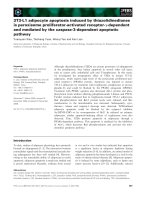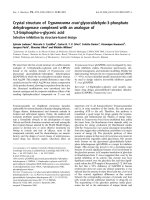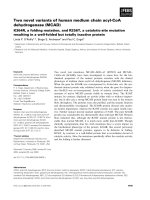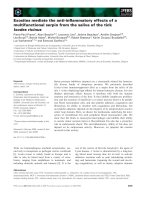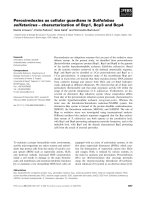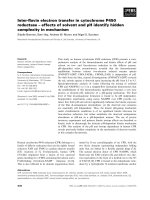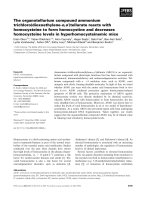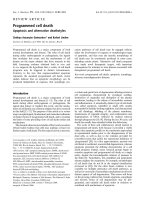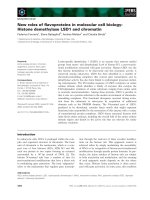Báo cáo khoa học: Vitamin D stimulates apoptosis in gastric cancer cells in synergy with trichostatin A ⁄sodium butyrate-induced and 5-aza-2¢-deoxycytidine-induced PTEN upregulation ppt
Bạn đang xem bản rút gọn của tài liệu. Xem và tải ngay bản đầy đủ của tài liệu tại đây (544.62 KB, 11 trang )
Vitamin D stimulates apoptosis in gastric cancer cells in
synergy with trichostatin A
⁄
sodium butyrate-induced and
5-aza-2¢-deoxycytidine-induced PTEN upregulation
Lina Pan
1,
*, Ammar F. Matloob
1,
*, Juan Du
2
, Hong Pan
1
, Zhixiong Dong
2
, Jing Zhao
2
, Yu Feng
1
,
Yun Zhong
1
, Baiqu Huang
2
and Jun Lu
1
1 The Institute of Genetics and Cytology, Northeast Normal University, Changchun, China
2 The Key Laboratory of Molecular Epigenetics of Ministry of Education (MOE), Northeast Normal University, Changchun, China
Introduction
Gastric cancer is the fourth commonest malignancy
worldwide, especially in East Asian countries such as
Japan and China [1]. The 5-year survival rate after
diagnosis of gastric cancer is 10–21% [2]. Surgery and
chemotherapy are the major therapeutic methods for
gastric cancer, but the rate of recurrence after curative
resection is high. Also, resistance to chemotherapeutic
agents and toxicity of drugs to normal tissues are the
main problems in gastric cancer therapies [3]. There-
fore, there is an ongoing search for new therapeutic
targets for gastric cancer.
The physiologically active form of vitamin D,
1,25-dihydroxyvitamin D
3
(VD3), belongs to the secos-
teroid hormone family, which controls calcium and
Keywords
1,25-dihydroxyvitamin D
3
; 5-aza-2¢-
deoxycytidine; gastric cancer; PTEN;
trichostatin A ⁄ sodium butyrate
Correspondence
J. Lu, Institute of Genetics and Cytology,
Northeast Normal University, 5268 Renmin
Street, Changchun 130024, China
Fax: +86 431 85099768
Tel: +86 431 85098729
E-mail:
*These authors contributed equally to this
work
(Received 8 June 2009, revised 22 October
2009, accepted 8 December 2009)
doi:10.1111/j.1742-4658.2009.07542.x
Previous studies have shown an anticancer effect of vitamin D, but the
mechanisms underlying this action have not been fully explored. Here we
show that 1,25-dihydroxyvitamin D3 (VD3, the active form of vitamin D)
significantly promoted apoptosis in the undifferentiated gastric cancer cell
line HGC-27, and this was accompanied by a concurrent increase in phos-
phatase and tensin homolog deleted on chromosome 10 (PTEN) expression
on VD3 treatment. In contrast, knockdown of PTEN expression by stable
transfection of PTEN small interfering RNA greatly decreased the apo-
ptosis rate. We further demonstrated that VD3 induced PTEN expression
through vitamin D receptor. In addition, our evidence showed that vita-
min D receptor, Egr-1 and p300 induced PTEN expression in a synergistic
fashion. Furthermore, we found that the histone deacetylase inhibitors
trichostatin A and sodium butyrate and the methylation inhibitor
5-aza-2¢-deoxycytidine played important roles in vitamin D-induced apopto-
sis through PTEN upregulation. The data presented in this article suggest
potential benefits of vitamin D in gastric cancer therapies in association
with the use of trichostatin A ⁄ sodium butyrate and 5-aza-2¢-deoxycytidine.
Structured digital abstract
l
MINT-7306489, MINT-7306501, MINT-7306512: P300 (uniprotkb:Q09472) physically inter-
acts (
MI:0914) with VDR (uniprotkb:P11473) and EGR1 (uniprotkb:P18146)byanti bait co-
immunoprecipitation (
MI:0006)
Abbreviations
5-Aza, 5-aza-2¢-deoxycytidine; ChIP, chromatin immunoprecipitation; CoIP, coimmunoprecipitation; Egr-1, early growth response gene 1;
FITC, fluorescein isothiocyanate; HDAC, histone deacetylase; NaBu, sodium butyrate; PI, propidium iodide; PTEN, phosphatase and tensin
homolog deleted on chromosome 10; siRNA, small interfering RNA; TSA, trichostatin A; VD3, 1,25-dihydroxyvitamin D
3;
VDR, vitamin D
receptor.
FEBS Journal 277 (2010) 989–999 ª 2010 The Authors Journal compilation ª 2010 FEBS 989
phosphorus metabolism in normal development. Ear-
lier studies revealed that VD3 could induce differentia-
tion and cell cycle arrest in a number of malignant
melanoma cells, including those in myeloid leukemia,
and breast, prostate, colon, skin and brain cancer [4–
8].
Phosphatase and tensin homolog deleted on chromo-
some 10 (PTEN) was originally discovered in 1997
[9–11]. PTEN is a negative regulator of the ubiquitous
phosphatidylinositol 3-kinase pathway, and it is fre-
quently subject to loss of heterozygosity in various
human tumors, including brain, bladder, prostate and
endometrial cancers [9,10]. Expression of PTEN is reg-
ulated by transcription factors such as p53 [12], peroxi-
some proliferator-activated receptor c [13], early
growth response gene 1 (Egr-1) [14], nuclear factor-jB
[15,16], and transforming growth factor-b [11]. More-
over, functional vitamin D receptor (VDR) elements
have been identified in the promoter of PTEN, sug-
gesting that vitamin D may play a role in the regula-
tion of PTEN expression [17].
Epigenetic changes such as DNA methylation and
histone modifications play important roles in silenc-
ing tumor suppressor genes. During the development
and progression of gastric cancer, a number of
tumor-related genes, including p53 [18], E-cadherin
[19,20], p14 [21], p15 [22,23], p16 [24], PTEN [25],
and RASSF1A [25], exhibit genetic and epigenetic
alterations. Some of these genes can be reactivated
by the DNA methylation inhibitor 5-aza-2¢-deoxycyti-
dine (5-Aza) [26]. Earlier studies showed that treat-
ment with 5-Aza reduced DNA methylation and
subsequently upregulated PTEN expression in acute
lymphoblastic leukemia, melanoma and ovarian can-
cer cells [27–29]. In gastric cancer cells, treatment
with 5-Aza can greatly enhance PTEN expression
[30]. It was also reported that use of 5-Aza in com-
bination with histone deacetylase (HDAC) inhibitors
may be an effective chemotherapeutic regimen for
patients with acute myeloid leukemia that is resistant
to conventional chemotherapy [31]. Additionally,
there has been evidence that HDAC inhibitors can
improve the sensitivity of actinotherapy and chemo-
therapy [32,33].
The main aim of this study was, on the basis of the
above information, to determine whether vitamin D
had any effects on gastric cancer cells, and to investi-
gate the possible molecular processes involved in this
action. As there has been evidence that the promoter
of PTEN is hypermethylated in gastric cancer [34], we
wanted to determine whether epigenetic modifiers such
as 5-Aza and trichostatin A (TSA) ⁄ sodium butyrate
(NaBu) could change the expression of PTEN in gas-
tric cancer cells. Moreover, we also intended to clarify
the functional relationship between VDR and Egr-1,
which is a major transcription factor of PTEN, in
PTEN regulation and in PTEN-mediated cellular alter-
ations in gastric cancer cells. Overall, data arising from
this study have provided the basis for the further
investigations into the potential application of vita-
min D as a novel molecular target in gastric cancer
therapies in association with the use of TSA ⁄ NaBu
and 5-Aza.
Results
Vitamin D induced apoptosis in gastric cancer
cells through PTEN upregulation
Earlier studies revealed that vitamin D was able to
induce cell differentiation and cell cycle arrest, in
addition to its normal function of controlling cal-
cium and phosphorus metabolism [4–8]. To confirm
this effect of vitamin D in gastric cancer, we treated
undifferentiated HGC-27 adenocarcinoma cells with
VD3, and estimated the apoptosis rate. As shown in
Fig. 1A, the early apoptosis rate (Bd) was increased
from 1.03% to 5.87%, and the late apopto-
sis ⁄ necrotic ratio (Bb) was increased from 1.46% to
5.55%, confirming that vitamin D could induce
apoptosis in gastric cancer cells. As functional
VDREs were identified in the PTEN promoter [17],
and the expression of PTEN declined in gastric can-
cer [35], we speculated that PTEN might participate
in the VD3-induced apoptosis in gastric cancer cells.
To investigate this, undifferentiated HGC-27 adenocar-
cinoma cells were treated with VD3, and the expression
of PTEN was examined. The results in Fig. 1B show
that PTEN expression was upregulated by VD3 at both
the mRNA (upper) and protein (lower) levels. To fur-
ther establish the functional role of PTEN in VD3-
induced apoptosis, we constructed a stably transfected
cell line in which PTEN was knocked down by specific
small interfering RNA (siRNA). The inhibitory effi-
ciency of PTEN siRNA was first examined by using
real-time RT-PCR (data not shown), and two clones
with the highest RNA inhibitory efficiency were selected
and further confirmed by using western blotting
(Fig. 1C). Eventually, clone 2 was used in the following
experiments. We then showed that the early apoptosis
rate (Bd, Fig. 1) was significantly reduced from 3.94%
to 1.31% in cells transfected with PTEN siRNA, as
compared with cells transfected with control siRNA
(Fig. 1D). Meanwhile, the early apoptosis induced by
VD3 was reduced from 6.06% to 2.12% in PTEN siR-
NA cells (Fig. 1D). These results suggested that PTEN
Vitamin D induces apoptosis through PTEN L. Pan et al.
990 FEBS Journal 277 (2010) 989–999 ª 2010 The Authors Journal compilation ª 2010 FEBS
participated in the VD3-induced apoptosis in gastric
cancer cells.
Vitamin D upregulated PTEN through VDR
To further study the mechanism by which vitamin D
induces PTEN expression, we transiently transfected
HGC-27 cells with the expression plasmid of VDR
for luciferase reporter assay. The results showed that
overexpression of VDR stimulated the activity of the
PTEN promoter (Fig. 2A). Similarly, exposure of
HGC-27 cells to VD3 after VDR transfection upreg-
ulated PTEN mRNA expression as much as 13-fold
(Fig. 2B). As can be seen in Fig. 2C, the PTEN pro-
tein level was also enhanced by VDR overexpression.
Furthermore, we designed three primer pairs on the
PTEN promoter for chromatin immunoprecipitation
(ChIP) assays with antibody against VDR in HGC-
27 cells (Fig. 2D). The ChIP data clearly demon-
strated the binding of VDR to the PTEN promoter,
especially on the RE B region (Fig. 2E). These data
indicated that vitamin D induced PTEN expression
through binding of VDR to the PTEN promoter.
VDR synergistically activated PTEN with Egr-1
and p300
In a previous study, we showed that histone acetyl-
transferase p300 activated PTEN expression in synergy
with the transcriptional factor Egr-1 [36]. To clarify the
relationships among VDR, Egr-1 and p300 in regulat-
ing PTEN expression, we transiently transfected 293T
cells with VDR, Egr-1 and p300, either alone or in
combination, before the expression of PTEN was esti-
mated. As shown in Fig. 3A, overexpression of VDR
or p300 alone increased PTEN promoter activity by
three-fold or four-fold. Meanwhile, cotransfection with
VDR ⁄ Egr-1, VDR ⁄ p300, Egr-1 ⁄ p300 and VDR⁄ Egr-
1 ⁄ p300 resulted in the enhancement of PTEN promoter
activity by 28-fold, 68-fold, 51-fold and over 700-fold,
respectively (Fig. 3A). Similar results were obtained by
using quantitative real-time PCR (Fig. 3B) and western
A
BD
C
10
3
10
2
10
1
10
0
10
3
10
2
10
1
10
0
10
3
10
2
10
1
10
0
10
3
10
2
10
1
10
0
10
3
10
2
10
1
10
0
10
3
10
2
10
1
10
0
10
0
10
1
10
2
**
10
3
10
0
10
1
10
2
10
3
10
0
10
1
10
2
10
3
10
0
10
1
10
2
10
3
10
0
10
1
10
2
10
3
10
0
10
1
10
2
10
3
Annexin V-FITC
Annexin V-FITC
Annexin V-FITC
Annexin V-FITC
Annexin V-FITC
Annexin V-FITC
0.73%
1.46%
B1
B3 B4
B2
B1
B3
B4
B2
B1
B3
B4
B2
B1
B3
B4
B2
B1
B3
B4
B2
B1
B3
B4
B2
PI
PI
PIPI
PI PI
Control
Control Control
1.03%
1.68%
5.55%
VD3
VD3 VD3
5.87%
1
0.5
0.3
α-PTEN
α-actin
α-PTEN
α-actin
Control #1 #2
40
30
20
4
3
2
1
0
Relative mRNA level
Control VD3
Control
VD3
1 1.8
Control siRNA
PTEN siRNA
3.05%
1.11%
2.09%
0.68%
3.94%
1.31%
3.26%
0.53%
3.16%
6.06%
2.12%
0.94%
Fig. 1. Vitamin D induced apoptosis in gastric cancer cells through PTEN. HGC-27 gastric cancer cells were treated with VD3 (10
)7
M) for
24 h, and the apoptosis was evaluated by flow cytometry. Apoptosis rates were calculated on the basis of 30 000 cells (A). HGC-27 cells
were cultured in six-well plates, and after exposure to VD3 for 24 h, cells were collected for quantitative real-time PCR and western blotting
(B). HGC-27 cells were transfected with siRNA targeting PTEN to construct stably transfected cell lines. After being cultured with G418 for
15–22 days, individual colonies were isolated and expanded, and the expression of PTEN was examined by western blotting (C). Colony 2
was treated with VD3, and apoptosis was evaluated (D). *P < 0.05, **P < 0.01, (n = 3).
L. Pan et al. Vitamin D induces apoptosis through PTEN
FEBS Journal 277 (2010) 989–999 ª 2010 The Authors Journal compilation ª 2010 FEBS 991
blotting (Fig. 3C). These experimental data clearly
indicated that VDR, Egr-1 and p300 were able to
work in synergy to significantly upregulate PTEN
expression.
Next, we sought to explore the physical and func-
tional interactions among VDR, Egr-1 and p300 in
their synergistic action. We performed coimmunopre-
cipitation (CoIP) assays after VDR, Egr-1 and p300
transfection. We precipitated cell lysates with anti-
bodies against VDR, Egr-1 and p300, respectively. The
precipitates were then detected using immunoblotting
with the above-mentioned antibodies. The CoIP data
revealed that VDR, Egr-1 and p300 were present in
the same complex, supporting their cooperative effect
on PTEN regulation (Fig. 3D). Collectively, these
results showed that, as a nuclear receptor, VDR acted
together with transcription factor Egr-1 and histone
acetyltransferase p300 to upregulate PTEN expression.
pc3.1 pc3.1 VDRVDR
Control VD3
α-PTEN
α-VDR
α-actin
1
1.3
1.1
1.6
ATG
–1703 –1477 –920 –784 –413 –156
RE A RE B RE C
28
24
20
16
12
8
4
0
Relative luc assay
16
14
12
10
8
6
4
2
0
Relative mRNA level
pc3.1
VDR
**
pc3.1
VDR Control
VD3
7
6
5
4
3
2
1
RE A RE B RE C
α-VDR
IP/input
Control
Vitamin D
AB C
D
E
Fig. 2. Vitamin D upregulated PTEN through
its receptor VDR. HGC-27 cells were tran-
siently transfected for 30 h with the expres-
sion plasmid of VDR, and PTEN promoter
reporter activity was measured (A). HGC-27
cells were transiently transfected with the
pc3.1–VDR or pc3.1 vector before VD3
treatment, and the expression of PTEN was
estimated by quantitative PCR (B) and wes-
tern blotting (C). The diagram of PTEN pro-
moter and the regions amplified by PCR in
ChIP assays are shown (D). HGC-27 cells
were collected and precipitated with anti-
bodies against VDR after VD3 treatment,
and ChIP assays were performed to exam-
ine the binding of VDR on PTEN promoter
(E). IP, immunoprecipitation. *P < 0.05,
**P < 0.01, (n = 3).
WB: VDR
WB: Egr-1
WB: p300
IgG VDR IgG Egr-1 IgG p300IP: input
VDR –+–– +++–
Egr-1 +––+ –++–
p300 +––– +–++
α-PTEN
α-actin
1 2.5 1.1 1.3 1.7
1.9
1.9
2.0
pc3.1
VDR
Egr-1
p300
VDR + Egr-1
VDR + p300
Egr-1 + p300
VDR + Egr-1 + p300
pc3.1
VDR
Egr-1
p300
VDR + Egr-1
VDR + p300
Egr-1 + p300
VDR + Egr-1 + p300
*
*
*
**
**
**
**
0
20 40
60 80 600 700
800
Relative luc assay Relative mRNA level
05
10 15
20
25
30
35
D
C
BA
Fig. 3. VDR synergistically activated PTEN with Egr-1 and p300. Expression plasmids of VDR, Egr-1 and p300 were transiently transfected
either alone or in combination, as indicated, and the expression of PTEN was examined by reporter activity assay (A), quantitative PCR (B),
and western blotting (C). CoIP was used to detect the binding of VDR, Egr-1 and p300 after transient transfection with Egr-1, VDR and p300
(D). IP, immuno precipitation; WB, western blotting. *P < 0.05, **P < 0.01, (n = 3).
Vitamin D induces apoptosis through PTEN L. Pan et al.
992 FEBS Journal 277 (2010) 989–999 ª 2010 The Authors Journal compilation ª 2010 FEBS
Vitamin D enhanced the apoptosis induced by
TSA
⁄
NaBu
We showed above that histone acetyltransferase p300
increased PTEN expression synergistically with VDR
and Egr-1 (Fig. 3), implying that histone acetylation
modification may participate in this process. HDAC
inhibitors have emerged as accessory therapeutic
agents for multiple human cancers, because they can
restore the expression of certain tumor suppressor
genes [37]. Moreover, our experimental data revealed
that VD3 was able to increase the apoptosis rates
induced by TSA and NaBu (Fig. S1). We then tested
the effects of HDAC inhibitors on the expression of
PTEN, with emphasis on their synergistic action with
VD3. We treated HGC-27 cells with TSA and NaBu,
and assessed the expression level of PTEN. As
expected, PTEN mRNA expression was significantly
enhanced by NaBu (over 300-fold) and VD3 (over
30-fold), and a synergistic effect of the combined use
of NaBu and VD3 was seen (over 700-fold) (Fig. 4B).
A similar synergistic effect on the upregulation of
PTEN, by 109-fold, was detected with combined
treatment with TSA and VD3 (Fig. 4A). To further
investigate the function of PTEN and the cooperative
effect of HDAC inhibitors and vitamin D on apopto-
sis in gastric cancer cells, cell lines stably transfected
with PTEN siRNA were treated with TSA ⁄ NaBu,
either alone or with VD3, and it was found that the
cells transfected with PTEN siRNA exhibited a
decline in early apoptosis rate from 8.84% to 2.65%
with TSA treatment (Fig. 4C), and from 15.65% to
5.59% with NaBu treatment (Fig. 4D). Meanwhile,
the early apoptosis rate was greatly reduced, from
25.09% to 1.55% with both TSA and VD3 (Fig. 4C),
and from 24.12% to 5.84% with both NaBu and
VD3 (Fig. 4D). These results suggested that PTEN
participated in the apoptosis induced by HDAC
inhibitors, and that VD3 could promote the apoptosis
induced by TSA ⁄ NaBu.
Control
T + VD3
TSA
VD3
1.1 1 1.1 1.4
Control
NaBu
VD3
N + VD3
1.3 1 1.1 1.6
AB
TSA
1.91%
4.39%
2.65%
Control siRNA
Control siRNA
PTEN siRNAPTEN siRNA
TSA
0.79% 6.58%
8.84%
NaBu
0.86%
7.79%
15.65%
NaBu
1.53%
7.09%
5.59%
T + VD3
0.60%
16.31%
25.09%
T + VD3
4.71%
6.35%
1.55%
N + VD3
3.51%
6.63%
5.84%
N + VD3
1.91%
34.20%
24.12%
Annexin V-FITC
PI
Annexin V-FITC
PI
Annexin V-FITC
PI
Annexin V-FITC
PI
Annexin V-FITC
PI
Annexin V-FITC
PI
Annexin V-FITC
PI
Annexin V-FITC
PI
C
D
α
-PTEN
α
-actin
α
-PTEN
α
-actin
120
80
40
0
Control TSA TSA + VD3VD3
Relative mRNA level
Relative mRNA level
800
600
400
90
60
30
0
Control NaBu
NaBu + VD3
VD3
**
**
**
10
3
10
2
10
1
10
0
10
3
10
2
10
1
10
0
10
3
10
2
10
1
10
0
10
3
10
2
10
1
10
0
B1
B3
B4
B2
B1
B3 B4
B2
B1
B3 B4
B2
B1
B3
B4
B2
10
0
10
1
10
2
10
3
10
3
10
2
10
1
10
0
B1
B3 B4
B2
10
0
10
1
10
2
10
3
10
3
10
2
10
1
10
0
B1
B3 B4
B2
10
0
10
1
10
2
10
3
10
3
10
2
10
1
10
0
B1
B3
B4
B2
10
0
10
1
10
2
10
3
10
3
10
2
10
1
10
0
B1
B3 B4
B2
10
0
10
1
10
2
10
3
10
0
10
1
10
2
10
3
10
0
10
1
10
2
10
3
10
0
10
1
10
2
10
3
Fig. 4. Vitamin D enhanced the apoptosis induced by TSA ⁄ NaBu. HGC-27 gastric cancer cells were treated with VD3 and 200 nM TSA (A),
or VD3 and 2 m
M NaBu (B), and western blotting was used to evaluate PTEN expression. Cell lines stably transfected with PTEN siRNA or
control siRNA were treated with VD3 and TSA ⁄ NaBu, respectively, and apoptosis was evaluated by flow cytometry. The apoptosis rates
were calculated on the basis of 30 000 cells (C). *P < 0.05, **P < 0.01, (n = 3).
L. Pan et al. Vitamin D induces apoptosis through PTEN
FEBS Journal 277 (2010) 989–999 ª 2010 The Authors Journal compilation ª 2010 FEBS 993
TSA
⁄
NaBu increased the histone acetylation
level at the PTEN promoter
Next, we wanted to investigate whether TSA ⁄ NaBu
truly altered the histone acetylation level at the PTEN
promoter. We performed ChIP assays with antibodies
against acetylated histones after TSA ⁄ NaBu treat-
ments. The results showed that TSA was able to
enhance the acetylation level of histone H3 at all three
regions of the PTEN promoter (Fig. 5A, left), whereas
it enhanced acetylation of histone H4 only at the RE
C region (Fig. 5A, right). Meanwhile, NaBu induced
hyperacetylation of both histone H3 (Fig. 5B, left) and
histone H4 (Fig. 5B, right). These results indicated that
TSA ⁄ NaBu induced PTEN expression by enhancing
the histone acetylation levels at the gene’s promoter.
TSA
⁄
NaBu upregulated Egr-1 and promoted its
binding to the PTEN promoter
Histone hyperacetylation is believed to favor an open
chromatin structure to facilitate the binding of major
transcription factors on the promoter. We were
therefore interested in determining whether TSA ⁄ -
NaBu had any effects on promoting the binding of
Egr-1, a major transcription factor of PTEN. To do
this, we first examined the influences of TSA and
NaBu on the expression of Egr-1, and we found that
both TSA and NaBu upregulated Egr-1 in HGC-27
cells (Fig. 5C). Consistent with this, ChIP assays
with antibodies against Egr-1 demonstrated that TSA
could markedly potentiate the binding of Egr-1 to
the PTEN promoter (Fig. 5D, left). The data pre-
sented above had revealed that the histone acetyla-
tion level of the PTEN promoter (Fig. 5A), as well
the binding ability of Egr-1, were increased by TSA
(Fig. 5D, left). Apparently, TSA treatment facilitated
the binding of Egr-1 by enhancing the acetylation
level of the PTEN promoter. In contrast, NaBu had
little effect on the binding of Egr-1 (Fig. 5D, right).
Taken together, these findings show that epige-
netic mechanisms such as acetylation modification
play an important role in the regulation of PTEN
expression.
DB
α-Egr-1
α-actin
Control TSA
1
2.7
α-Egr-1
α-actin
Control NaBu
1
1.5
C
A
25
20
15
10
5
0
25
30
20
15
10
5
0
Control
TSA
*
*
*
PTEN/GAPDH
PTEN/GAPDH
RE A RE B
RE C RE A RE B RE C
RE A RE B RE C RE A RE B
RE C
RE A RE B RE C RE A RE B RE C
Ac-H3 Ac-H4
Ac-H3
Ac-H4
10
8
6
4
2
0
PTEN/GAPDH
PTEN/GAPDH
10
8
6
4
2
0
Control
Control
Control
Control
Control
TSA
TSA
Control
NaBu
TSA
*
**
**
**
**
**
*
*
*
Control
NaBu
2.0
1.6
1.2
0.8
0.4
0.0
Relative mRNA level
Relative mRNA level
NaBu
NaBu
*
*
20
16
12
8
4
0
7
6
5
4
3
2
1
0
IP/input
IP/input
α-Egr-1 α-Egr-1
2.5
2.0
1.5
1.0
0.5
0.0
Egr-1 Egr-1
Fig. 5. TSA ⁄ NaBu increased the histone acetylation level on the PTEN promoter. HGC-27 cells were treated with TSA or NaBu for 24 h, and
ChIP assays were performed with antibodies against Ac-H3 or Ac-H4 after TSA (A) and NaBu (B) stimulation. HGC-27 cells were treated with
TSA for 24 h, the mRNA level of Egr-1 was determined by quantitative PCR (C, left upper), and the protein level was estimated by western
blotting (C, left lower). The expression level of Egr-1 was evaluated by quantitative PCR and western blotting after NaBu treatment (C, right).
The change in Egr-1 binding to the PTEN promoter after stimulation was examined by ChIP assays (D). GAPDH, glyceraldehyde-3-phosphate
dehydrogenase; IP, immuno precipitation. *P < 0.05, **P < 0.01, (n = 3).
Vitamin D induces apoptosis through PTEN L. Pan et al.
994 FEBS Journal 277 (2010) 989–999 ª 2010 The Authors Journal compilation ª 2010 FEBS
Vitamin D promoted the apoptosis induced by
5-Aza
We then investigated the effect of PTEN on the apop-
tosis induced by DNA methylation and vitamin D in
gastric cancer cells. We treated HGC-27 cells with
5-Aza and VD3, either alone or in combination, and
we found that the expression of PTEN was upregulat-
ed by over 100-fold after combined treatment with
5-Aza and VD3 (Fig. 6A). Meanwhile, the early apop-
tosis rate dropped sharply from 26.45% to 2.44%, and
the late apoptosis ⁄ necrotic rate declined from 17.74%
to 7.59%, in PTEN siRNA-transfected cells treated
with 5-Aza and VD3 (Fig. 6B). Clearly, 5-Aza was
able to promote the apoptosis induced by vitamin D
through PTEN.
5-Aza induced Egr-1 expression and enhanced its
binding to the PTEN promoter
It has been shown that 5-Aza is able to stimulate PTEN
expression and to induce apoptosis in acute lymphoblas-
tic leukemia cells [27]. To evaluate the contribution of 5-
Aza to the regulation of PTEN in gastric cancer cells,
we treated HGC-27 cells with 5-Aza; as a result, both
Egr-1 mRNA and protein levels were increased six-fold
(Fig. 6C). Furthermore, ChIP assays with antibody
against Egr-1 showed that the binding of Egr-1 to the
PTEN promoter was increased after treatment with 5-
Aza (Fig. 6D). Thus, we concluded that PTEN partici-
pated in vitamin D-induced apoptosis, and epigenetic
modifications such as acetylation and DNA methylation
were involved in the regulation of PTEN, which subse-
quently affected the apoptosis of gastric cancer cells.
Discussion
Recent studies have revealed that vitamin D is involved
in the control of various cellular processes, including cel-
lular growth, differentiation, and apoptosis, in addition
to its known functions in calcium and phosphorus
metabolism [4–8]. In the present study, we have shown
that VD3 can induce apoptosis in gastric cancer cells
(Fig. 1A), suggesting its potential use in cancer therapy.
However, it has been noted that vitamin D may possibly
be toxic when used in large amounts (i.e. greater than
50 000 IUÆday
)1
), because it can cause abnormally high
serum calcium levels (hypercalcemia) [38]. Moreover,
there is increasing evidence that HDAC inhibitors (e.g.
TSA and NaBu) and methylation inhibitors (e.g. 5-Aza)
can reactivate the expression of silenced genes, and
hence restore normal cellular functions; this has inspired
a great deal of research interest in potential uses of these
modifiers in tumor therapy [39,40]. In this study, we
explored the effects, as well as some underlying mecha-
nisms, of the combined use of VD3 and TSA ⁄ NaBu or
Control siRNA
B1 B2
B3 B4
B1 B2
B3 B4
B1 B2
B3 B4
B1 B2
B3 B4
1.87%
10.93%
5-Aza
5-Aza
11.60%
PIPI
PI
PI
10
3
10
2
10
1
10
0
10
0
10
1
10
2
10
3
10
3
10
2
10
1
10
0
10
0
10
1
10
2
10
3
10
3
10
2
10
1
10
0
10
0
10
1
10
2
10
3
10
3
10
2
10
1
10
0
10
0
10
1
10
2
10
3
Annexin V-FITC
Annexin V-FITC Annexin V-FITC
Annexin V-FITC
PTEN siRNA
11.70%
4.88%
1.72%
0.57%
17.74%
5 + VD3
5 + VD3
26.45%
2.44%
3.94%
7.59%
160
120
40
30
20
10
0
Relative mRNA level
Relative mRNA level
Control
5-Aza
5-Aza + VD3
VD3
**
**
**
PTEN
8
6
4
2
0
Control 5-Aza
Egr-1
40
35
30
25
20
15
10
5
0
IP/input
RE A
RE B
RE C
Control
5-Aza
*
*
5-Aza
Control
1
1.6
α-Egr-1
α-Egr-1
α-actin
*
*
*
1
1.3 1.1
1.9
α-PTEN
α-actin
Control
5-Aza
VD3
5-Aza + VD3
AB
CD
Fig. 6. Vitamin D promoted the apoptosis
induced by 5-Aza. HGC-27 cells were trea-
ted with VD3 and 5-Aza (5 l
M), and western
blotting was used to assess PTEN expres-
sion (A). Cell lines stably transfected with
PTEN siRNA or control siRNA were treated
with VD3 and 5-Aza, and apoptosis was
evaluated by flow cytometry. The apoptosis
rates were calculated on the basis of
30 000 cells (B). HGC-27 cells were cultured
in six-well plates before 5-Aza treatment,
and the expression of Egr-1 was examined
by quantitative PCR (C, upper) and western
blotting (C, lower). After exposure to 5-Aza
for 24 h, HGC-27 cells were collected and
precipitated with the antibody against Egr-1,
and the binding of Egr-1 was detected by
ChIP assays (D). IP, immunoprecipitation.
*P < 0.05, **P < 0.01, (n = 3).
L. Pan et al. Vitamin D induces apoptosis through PTEN
FEBS Journal 277 (2010) 989–999 ª 2010 The Authors Journal compilation ª 2010 FEBS 995
5-Aza, on gastric cancer cells. Our results indicated that
both TSA and NaBu could significantly promote the
apoptosis induced by VD3 (Fig. 4C,D). Moreover, our
study showed that VDR acted as a transcription factor
of PTEN (Fig. 2). Significantly, our study also revealed
that both TSA ⁄ NaBu and 5-Aza promoted the forma-
tion of an open chromatin structure that potentiated the
binding of VDR to the PTEN promoter, and that VDR
was in turn activated by its ligand VD3. Overall, these
data may help in the development of a novel option for
accessory cancer therapy involving the combined use of
vitamin D and epigenetic modifiers. This strategy also
has the advantage of the use of low concentrations of
vitamin D and HDAC inhibitors to minimize their tox-
icities, owing to their remarkable synergistic effects in
activating target genes.
An interesting finding of this study is the correlation
between VD3 and the tumor suppressor gene PTEN.
We showed that VD3 could induce the expression of
PTEN through VDR (Fig. 2). Furthermore, the data
in Fig. 3 also show correlations between VDR and
Egr-1, as well as between VDR and histone acetyl-
transferase p300. Further investigations revealed that
both TSA ⁄ NaBu and 5-Aza were able to significantly
enhance the apoptosis induced by VD3 through PTEN
(Figs 4 and 6), and that the epigenetic modifications
played important roles in monitoring the expression of
PTEN (Figs 5 and 6). Thus, the results presented in
this article suggest a working model in which a low
concentration of VD3 exerts its stimulating effects on
the induction of apoptosis in gastric cancer cells, and
this process is tightly associated with the action of epi-
genetic modification agents such as TSA ⁄ NaBu and 5-
Aza, which either directly, or through transcription
factor Egr-1, influence the expression of PTEN. Poten-
tially, our work may be useful as a clue for the devel-
opment of an optional therapeutic strategy for gastric
cancer involving the administration of vitamin D and
epigenetic modifiers.
Experimental procedures
Plasmids
The luciferase reporter construct of the PTEN promoter was
obtained by subcloning the 1978 bp genomic DNA region
upstream of the human PTEN gene into the pGL-3basic-luc
vector [14]. The human VDR expression plasmid was a gift
from Y. C. Li (Committee on Molecular Metabolism and
Nutrition, Biological Science Division, The University of
Chicago, IL, USA) [41]. The expression plasmid containing
the wild-type p300 was generously provided by J. Boyes
(Institute of Cancer Research, UK). The siRNA targeting
the PTEN gene (5¢-GACTTGAAGGCGTATACAG-3¢) [42]
was synthesized and cloned into the BamHI ⁄ HindIII sites in
the pSliencer 4.1–CMV neo vector (Ambion, Austin, TX,
USA), according to the published data.
Cell culture
Undifferentiated HGC-27 human gastric carcinoma and
293T human embryonic kidney epithelial cell lines were pur-
chased from the Institute of Cell Biology, Shanghai, China.
Cells were cultured in IMDM supplemented with 10% fetal
bovine serum, 100 UÆmL
)1
penicillin and 100 lgÆmL
)1
strep-
tomycin, and kept in a humidified atmosphere of 5% CO
2
.
Stably transfected cell lines were maintained in IMDM sup-
plemented with 10% fetal bovine serum in the presence of
G418 (1000 lgÆmL
)1
).
Assessment of apoptosis
Cells were seeded in 24-well plates and cultured for 18 h.
Following transient transfection or treatments with VD3
(Sigma), 5-Aza (Sigma), or TSA ⁄ NaBu (Sigma, St Louis,
MO, USA), cells were cultured for 24 h. The apoptosis
assay was performed by using the annexin V–fluorescein
isothiocyanate (FITC) apoptosis detection kit (Nanjingkaiji,
Nanjing, China), and analysis was by flow cytometry (exita-
tion at 488 nm; emission at 530 nm) with an FITC signal
detector, and prodium iodide (PI) staining with a phycoery-
thrin emission signal detector. The apoptosis rates were
calculated on the basis of 30 000 cells.
Transient transfection and luciferase reporter
assay
For transient transfection, cells were seeded in 24-well
plates and cultured for 18 h, before being transfected using
Lipofectamine 2000 (Invitrogen, Carlsbad, CA, USA).
After transfection, cells were cultured for 30 h before har-
vest, washed with NaCl ⁄ P
i
, and lysed in 30 lL of lysis buf-
fer. Reporter gene expression was measured and quantified
using a dual Luciferase Reporter Assay System (Promega,
Madison, WI, USA). Relative luciferase activity was ana-
lyzed by using a Turner Designs TD20 ⁄ 20 Luminometer
(Sunnyvale, CA , USA). Firefly luciferase activity was nor-
malized to the activity of the Renilla luciferase control.
Extracts from at least three independent transfection experi-
ments were assayed in triplicate. The results are shown as
means ± standard deviations.
RNA isolation and quantitative real-time PCR
Total RNA was extracted following the TaKaRa RNAiso
Reagent manual, and reverse transcribed into cDNA using
the RT system supplied by Promega. The resultant cDNA
Vitamin D induces apoptosis through PTEN L. Pan et al.
996 FEBS Journal 277 (2010) 989–999 ª 2010 The Authors Journal compilation ª 2010 FEBS
was diluted five-fold with RNase-free water. Quantitative
real-time PCR was performed on an ABI Prism 7000
Sequence Detection System (Applied Biosystems, Foster
City, CA, USA), using SYBR Green (Toyobo, Japan) as a
dsDNA-specific fluorescent dye. b-Actin was used for
standardizing PTEN and Egr-1 mRNA. Amplification prim-
ers were 5¢-ACCAGTGGCACTGTTGTTTCAC-3 ¢ and
5¢-TTCCTCTGGTCCTGGTATGAAG-3¢ for the PTEN
gene [43], and 5¢-AGCCCTACGAGCACCTG-3¢ and
5¢-CGGTGGGTTGGTCATG-3¢ for the Egr-1 gene [36].
Data were analyzed by using the 2
)DDCt
method [44]. All
results represent means ± standard deviations of three
independent experiments.
Western blot and CoIP
Cells were treated with VD3 (10
)7
m), TSA (200 nm), NaBu
(2 mm), or 5-Aza (5 lm), incubated for 24 h, and then lysed
in lysis buffer (50 mm Tris ⁄ HCl, 1% Nonidet P-40, 150 mm
NaCl, 1 mm EDTA, and 1 mm phenylmethanesulfonyl fluo-
ride). Cell lysates were separated by SDS ⁄ PAGE in 15%
gels, then transferred to poly(vinylidene difluoride) mem-
branes (Millipore, Bedford, MA, USA), and subjected to
western blot analysis with rabbit polyclonal antibodies
against PTEN (Abcam, Cambridge, MA, USA) or Egr-1
(Santa Cruz Biotechnology, Santa Cruz, CA, USA), and
mouse monoclonal antibody against b-actin (Sigma). The
signals were visualized by using the chemiluminescent sub-
strate method with the SuperSignal West Pico kit provided
by Pierce Co. (Rockford, IL, USA).
Coprecipitation of VDR with Egr-1 and p300 was per-
formed in 293T cells, using a protocol described previously
[45]. The antibodies against Egr-1, VDR and p300 were
used for immunoprecipitation and western blotting.
Construction of stably transfected cell lines
HGC-27 cells were transfected with pSliencer 4.1–CMV
neo-siPTEN or pSliencer 4.1–CMV neo vector, using the
Lipofectamine 2000 (Invitrogen) protocol. Cells were main-
tained in IMDM supplemented with 10% fetal bovine
serum, 100 mgÆmL
)1
penicillin, 100 mgÆmL
)1
streptomycin,
and 1000 lgÆmL
)1
G418. After 15–22 days, individual
clones were isolated and expanded. The expression of PTEN
was knocked down in the cell lines with pSliencer 4.1–CMV
neo-siPTEN.
ChIP
ChIP assays were carried out using a kit supplied by
Upstate, following the manufacturer’s protocol. Cells were
plated at a density of 1 · 10
5
⁄ mL in six-well plates and cul-
tured for 24 h. After treatments with TSA ⁄ NaBu or 5-Aza,
cells were crosslinked in 2% formaldehyde for 10 min at
37 °C, and then lysed in SDS lysis buffer (1% SDS, 10 mm
EDTA, 50 mm Tris, pH 8.1) with protease inhibitors. The
sonicated lysates were processed using a ChIP assay kit,
essentially as described by the manufacturer (Upstate Bio-
technology, Lake Placid, NY, USA). Antibodies against
Ac-H3 and Ac-H4 were purchased from Upstate. Antibody
against Egr-1 was purchased from Santa Cruz. Immunopre-
cipitated chromatin was analyzed by quantitative PCR
(ABI Prism 7000 Sequence Detection System Instrument,
Applied Biosystems), using SYBR green dye with primers
specific to sequences at the PTEN promoter.
Statistical analysis
Student’s test was used to calculate the statistical signifi-
cance of the experimental data. The level of significance
was set as *P < 0.05 and **P < 0.01.
Acknowledgements
We thank E. Adamson (Burnham Institute, USA) and
Y. Chun Li (Committee on Molecular Metabolism and
Nutrition, Biological Science Division, The University
of Chicago, Chicago, IL, USA) for providing plasmids.
This work was supported by grants from The National
Basic Research Program of China (2005CB522404 and
2006CB910506), The Program for Changjiang Scholars
and Innovative Research Team (PCSIRT) in Universi-
ties (IRT0519), and The National Natural Science
Foundation of China (30771232 and 30671184).
References
1 Peek RM Jr & Blaser MJ (2002) Helicobacter pylori
and gastrointestinal tract adenocarcinomas. Nat Rev
Cancer 2, 28–37.
2 Phan AT & Ajani JA (2004) Gastric carcinoma. Curr
Oncol Rep 6 , 192–198.
3 Rivera F, Vega-Villegas ME & Lopez-Brea MF (2007)
Chemotherapy of advanced gastric cancer. Cancer Treat
Rev 33, 315–324.
4 DeLuca HF (2004) Overview of general physiologic fea-
tures and functions of vitamin D. Am J Clin Nutr 80,
1689S–1696S.
5 Feldman D, Zhao XY & Krishnan AV (2000)
Vitamin D and prostate cancer. Endocrinology 141, 5–9.
6 Holick MF (2004) Sunlight and vitamin D for bone
health and prevention of autoimmune diseases, cancers,
and cardiovascular disease. Am J Clin Nutr 80, 1678S–
1688S.
7 Holick MF (2004) Vitamin D: importance in the pre-
vention of cancers, type 1 diabetes, heart disease, and
osteoporosis. Am J Clin Nutr 79, 362–371.
L. Pan et al. Vitamin D induces apoptosis through PTEN
FEBS Journal 277 (2010) 989–999 ª 2010 The Authors Journal compilation ª 2010 FEBS 997
8 Norman AW, Bishop JE, Bula CM, Olivera CJ,
Mizwicki MT, Zanello LP, Ishida H & Okamura WH
(2002) Molecular tools for study of genomic and rapid
signal transduction responses initiated by
1 alpha,25(OH)(2)-vitamin D(3). Steroids 67, 457–466.
9 Li J, Yen C, Liaw D, Podsypanina K, Bose S, Wang
SI, Puc J, Miliaresis C, Rodgers L, McCombie R et al.
(1997) PTEN, a putative protein tyrosine phosphatase
gene mutated in human brain, breast, and prostate
cancer. Science 275, 1943–1947.
10 Steck PA, Pershouse MA, Jasser SA, Yung WK, Lin H,
Ligon AH, Langford LA, Baumgard ML, Hattier T,
Davis T et al. (1997) Identification of a candidate
tumour suppressor gene, MMAC1, at chromo-
some 10q23.3 that is mutated in multiple advanced
cancers. Nat Genet 15, 356–362.
11 Li DM & Sun H (1997) TEP1, encoded by a candidate
tumor suppressor locus, is a novel protein tyrosine
phosphatase regulated by transforming growth factor
beta. Cancer Res 57, 2124–2129.
12 Stambolic V, MacPherson D, Sas D, Lin Y, Snow B,
Jang Y, Benchimol S & Mak TW (2001) Regulation
of PTEN transcription by p53. Mol Cell 8, 317–325.
13 Patel L, Pass I, Coxon P, Downes CP, Smith SA &
Macphee CH (2001) Tumor suppressor and anti-
inflammatory actions of PPARgamma agonists are
mediated via upregulation of PTEN. Curr Biol 11,
764–768.
14 Virolle T, Adamson ED, Baron V, Birle D, Mercola D,
Mustelin T & de BelleI (2001) The Egr-1 transcription
factor directly activates PTEN during irradiation-
induced signalling. Nat Cell Biol 3, 1124–1128.
15 Kim S, Domon-Dell C, Kang J, Chung DH, Freund JN
& Evers BM (2004) Down-regulation of the tumor
suppressor PTEN by the tumor necrosis factor-alpha ⁄
nuclear factor-kappaB (NF-kappaB)-inducing
kinase ⁄ NF-kappaB pathway is linked to a default Ikap-
paB-alpha autoregulatory loop. J Biol Chem 279, 4285–
4291.
16 Vasudevan KM, Gurumurthy S & Rangnekar VM
(2004) Suppression of PTEN expression by NF-kappa B
prevents apoptosis. Mol Cell Biol 24, 1007–1021.
17 Hisatake J, O’Kelly J, Uskokovic MR, Tomoyasu S &
Koeffler HP (2001) Novel vitamin D(3) analog, 21-(3-
methyl-3-hydroxy-butyl)-19-nor D(3), that modulates
cell growth, differentiation, apoptosis, cell cycle, and
induction of PTEN in leukemic cells. Blood 97,
2427–2433.
18 Tamura G, Kihana T, Nomura K, Terada M, Sugimura
T & Hirohashi S (1991) Detection of frequent p53 gene
mutations in primary gastric cancer by cell sorting and
polymerase chain reaction single-strand conformation
polymorphism analysis. Cancer Res 51, 3056–3058.
19 Becker KF, Atkinson MJ, Reich U, Becker I, Nekarda
H, Siewert JR & Hofler H (1994) E-cadherin gene
mutations provide clues to diffuse type gastric carcino-
mas. Cancer Res 54, 3845–3852.
20 Tamura G, Sakata K, Nishizuka S, Maesawa C, Suzuki
Y, Iwaya T, Terashima M, Saito K & Satodate R
(1996) Inactivation of the E-cadherin gene in primary
gastric carcinomas and gastric carcinoma cell lines. Jpn
J Cancer Res 87, 1153–1159.
21 Zhao YF, Zhang YG, Tian XX, Juan D & Jie Z (2007)
Aberrant methylation of multiple genes in gastric carci-
nomas. Int J Surg Pathol 15, 242–251.
22 Leung WK, Yu J, Ng EK, To KF, Ma PK, Lee TL,
Go MY, Chung SC & Sung JJ (2001) Concurrent hy-
permethylation of multiple tumor-related genes in gas-
tric carcinoma and adjacent normal tissues. Cancer 91,
2294–2301.
23 Sakellariou S, Liakakos T, Ghiconti I, Hadjikokolis
S, Nakopoulou L & Pavlakis K (2008) Immunohisto-
chemical expression of P15 (INK4B) and SMAD4 in
advanced gastric cancer. Anticancer Res 28, 1079–
1083.
24 Luo D, Zhang B, Lv L, Xiang S, Liu Y, Ji J & Deng D
(2006) Methylation of CpG islands of p16 associated
with progression of primary gastric carcinomas. Lab
Invest 86, 591–598.
25 Sato K, Tamura G, Tsuchiya T, Endoh Y, Sakata K,
Motoyama T, Usuba O, Kimura W, Terashima M,
Nishizuka S et al. (2002) Analysis of genetic and epige-
netic alterations of the PTEN gene in gastric cancer.
Virchows Arch 440, 160–165.
26 Momparler RL & Bovenzi V (2000) DNA methylation
and cancer. J Cell Physiol 183, 145–154.
27 Montiel-Duarte C, Cordeu L, Agirre X, Roman-Gomez
J, Jimenez-Velasco A, Jose-Eneriz ES, Garate L, And-
reu EJ, Calasanz MJ, Heiniger A et al. (2008) Resis-
tance to Imatinib Mesylate-induced apoptosis in acute
lymphoblastic leukemia is associated with PTEN down-
regulation due to promoter hypermethylation. Leuk Res
32, 709–716.
28 Mirmohammadsadegh A, Marini A, Nambiar S,
Hassan M, Tannapfel A, Ruzicka T & Hengge UR
(2006) Epigenetic silencing of the PTEN gene in
melanoma. Cancer Res 66, 6546–6552.
29 Schondorf T, Ebert MP, Hoffmann J, Becker M, Moser
N, Pur S, Gohring UJ & Weisshaar MP (2004) Hyper-
methylation of the PTEN gene in ovarian cancer cell
lines. Cancer Lett 207, 215–220.
30 Sun D, Toan X, Zhang Y, Chen Y, Lu R, Wang X &
Fang J (2008) Mammalian target of rapamycin pathway
inhibition enhances the effects of 5-aza-dC on suppress-
ing cell proliferation in human gastric cancer cell lines.
Sci China C Life Sci 51, 640–647.
31 Shaker S, Bernstein M, Momparler LF & Momparler
RL (2003) Preclinical evaluation of antineoplastic activ-
ity of inhibitors of DNA methylation (5-aza-2¢-deoxy-
cytidine) and histone deacetylation (trichostatin A,
Vitamin D induces apoptosis through PTEN L. Pan et al.
998 FEBS Journal 277 (2010) 989–999 ª 2010 The Authors Journal compilation ª 2010 FEBS
depsipeptide) in combination against myeloid leukemic
cells. Leuk Res 27, 437–444.
32 Geng L, Cuneo KC, Fu A, Tu T, Atadja PW &
Hallahan DE (2006) Histone deacetylase (HDAC)
inhibitor LBH589 increases duration of gamma-H2AX
foci and confines HDAC4 to the cytoplasm in irradiated
non-small cell lung cancer. Cancer Res 66, 11298–11304.
33 Qian DZ, Kato Y, Shabbeer S, Wei Y, Verheul HM,
Salumbides B, Sanni T, Atadja P & Pili R (2006)
Targeting tumor angiogenesis with histone deacetylase
inhibitors: the hydroxamic acid derivative LBH589. Clin
Cancer Res 12, 634–642.
34 Kang YH, Lee HS & Kim WH (2002) Promoter meth-
ylation and silencing of PTEN in gastric carcinoma.
Lab Invest 82, 285–291.
35 Fei G, Ebert MP, Mawrin C, Leodolter A, Schmidt N,
Dietzmann K & Malfertheiner P (2002) Reduced PTEN
expression in gastric cancer and in the gastric mucosa
of gastric cancer relatives. Eur J Gastroenterol Hepatol
14, 297–303.
36 Pan L, Lu J, Wang X, Han L, Zhang Y, Han S &
Huang B (2007) Histone deacetylase inhibitor
trichostatin a potentiates doxorubicin-induced apoptosis
by up-regulating PTEN expression. Cancer 109, 1676–
1688.
37 Finnin MS, Donigian JR, Cohen A, Richon VM,
Rifkind RA, Marks PA, Breslow R & Pavletich NP
(1999) Structures of a histone deacetylase homologue
bound to the TSA and SAHA inhibitors. Nature 401,
188–193.
38 Holick MF (2007) Vitamin D deficiency. N Engl J Med
357, 266–281.
39 Johnstone RW (2002) Histone-deacetylase inhibitors:
novel drugs for the treatment of cancer. Nat Rev 1,
287–299.
40 Jones PA & Baylin SB (2002) The fundamental role of
epigenetic events in cancer. Nat Rev 3, 415–428.
41 Szeto FL, Sun J, Kong J, Duan Y, Liao A, Madara JL
& Li YC (2007) Involvement of the vitamin D receptor
in the regulation of NF-kappaB activity in fibroblasts.
J Steroid Biochem Mol Biol 103, 563–566.
42 Dave B, Eason RR, Till SR, Geng Y, Velarde MC,
Badger TM & Simmen RC (2005) The soy isoflavone
genistein promotes apoptosis in mammary epithelial
cells by inducing the tumor suppressor PTEN. Carcino-
genesis 26, 1793–1803.
43 Tell G, Pines A, Arturi F, Cesaratto L, Adamson E,
Puppin C, Presta I, Russo D, Filetti S & Damante G
(2004) Control of phosphatase and tensin homolog
(PTEN) gene expression in normal and neoplastic
zthyroid cells. Endocrinology 145, 4660–4666.
44 Livak KJ & Schmittgen TD (2001) Analysis of relative
gene expression data using real-time quantitative PCR
and the 2(-Delta Delta C(T)) method. Methods 25, 402–
408.
45 Han S, Lu J, Zhang Y, Cheng C, Han L, Wang X, Li
L, Liu C & Huang B (2006) Recruitment of histone
deacetylase 4 by transcription factors represses interleu-
kin-5 transcription. Biochem J 400, 439–448.
Supporting information
The following supplementary material is available:
Fig. S1. Vitamin D enhanced the apoptosis induced
by the histone deacetylase (HDAC) inhibitors trichosta-
tin A (TSA) and sodium butyrate (NaBu), and the
methylation inhibitor 5-aza-2¢-deoxycytidine (5-Aza).
Fig. S2. Vitamin D induced apoptosis in gastric cancer
cells.
Fig. S3. Dose-dependent experiments with different
agents.
This supplementary material can be found in the
online version of this article.
Please note: As a service to our authors and readers,
this journal provides supporting information supplied
by the authors. Such materials are peer-reviewed and
may be re-organized for online delivery, but are not
copy-edited or typeset. Technical support issues arising
from supporting information (other than missing files)
should be addressed to the authors.
L. Pan et al. Vitamin D induces apoptosis through PTEN
FEBS Journal 277 (2010) 989–999 ª 2010 The Authors Journal compilation ª 2010 FEBS 999

